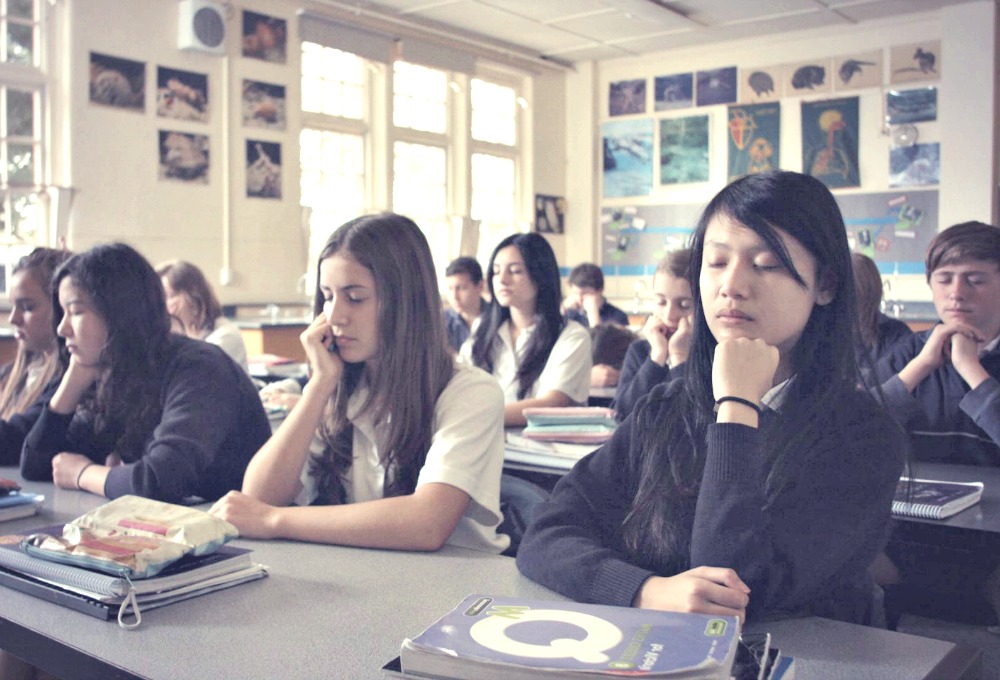Like physical health, mental health exists on a spectrum. We will all slide along that spectrum to varying degrees from time to time, and kids and teens are just as vulnerable to the dips. Increasingly (pleasingly!), research is focusing on the positive ways we can strengthen our mental health. In study after study, mindfulness meditation keeps coming up as a powerful way to do this.
What’s so great about mindfulness?
Mindfulness changes the structure and function of the brain in positive ways. Research has unlocked some of its wonders, but there will be more to come. The many positive benefits of mindfulness (and there are many!) include decreased anxiety, preservation of the brain’s gray matter (the tissue that contains the neurons), reduced depression and stress, and improved sleep quality – just to name a few.
We know that mindfulness does great things for adults, kids and adolescents, but until now, there has been little scientific proof about the benefits of incorporating a practice of mindfulness in the classroom.
Mindfulness and kids – An important study.
Recently, twelve Australian schools took part in a mindfulness meditation trial, to see if mindfulness could make a positive difference for students and teachers.
‘This is the largest study that we are aware of, worldwide, to evaluate the use of technology to support teachers to integrate mindfulness directly into their classrooms. The results of the study clearly demonstrate the capacity for our programs to positively impact on student and teacher wellbeing in a scalable and accessible way.’ – Dr Addie Wooten, Smiling Mind CEO.
The study involved seven inner metro schools, four outer metro schools, and one regional school. Altogether, 1853 students and 104 took part. Teachers were trained in mindfulness and the Smiling Mind program, and they participated in the five-week program. The students involved in the study were randomly assigned into two groups – one group did the mindfulness meditation and the other didn’t. Teachers and students were asked to use the program at least three times per week.
At the end of the trial, teachers and students reported significant improvements across a number of key areas, including sleep quality, well-being, the ability to manage and accept emotions, concentration, and school behaviour. The students who reported the biggest improvements were the ones who had greater levels of emotional distress at the beginning of the program.
Importantly, there were also significant reductions in bullying and disruptive behavior in the classroom.
Positive results from using mindfulness in the classroom have been found in a wide variety of government and non-government schools, in classes of all sizes and with kids of diverse backgrounds, locations and ages.
‘Mindfulness brings you to the present moment. It helps kids grapple with anxiety and emotions. Meditation regulates your emotions and provides a space between how you feel and how you react.’ Jane Martino, Smiling Mind founder.
But it doesn’t have to stay in the classroom.
Classroom, bedroom, home, car, outside – it doesn’t matter where mindfulness happens, just as long as it happens. The classroom is just one way to introduce a regular mindfulness practice to children but there are plenty. The important thing is to do something, and do it regularly.
Mindfulness involves being completely present for a while. Think of it like ‘watching’ thoughts and experiences (what you see, feel, hear) come and go, rather than letting them stay for long enough to turn into a worry or a feeling that stays too long, and intrudes too much (and we all have them!). Smiling Mind has created a mindfulness app which has several different mindfulness programs. It was developed by psychologists for people of all ages and can be downloaded for free here. For other fun, practical ways to introduce kids to a regular mindfulness practice, see here.
[irp posts=”802″ name=”Mindfulness: What. How. And The Difference 5 Minutes a Day Will Make”]



Mindfulness is just awesome, trying it for the past few days and now I’m able to focus more on my work.
Who conducted the study? Are there other apps that are just as useful? This seems simply to be a press release from Smiling Minds.
Katy I understand your concerns. This is not a press release for Smiling Minds but a summary of the research paper. Funding and support for the research was provided by the Department of Premier and Cabinet and the Department of Education and Training. Prof Peter Hart from Deakin University and InsightSRC undertook all the data analysis.
There may certainly be other apps, but this research was specifically undertaken in classrooms with the Smiling Minds program. The important point is that mindfulness can make a difference for students and teachers in the classroom. There are plenty of ways to practice mindfulness, the Smiling Minds app is just one. Plenty of other research has backed up the results of this study that mindfulness can make a positive difference for kids and adults.
Wow, that is remarkable! I am downloading the Smiling App now. 🙂
I have a question about my just turned three year old. About nine months ago we were awoken to the [very loud and unexpected] emergency alert system sounding in our apartment building during the middle of the night twice in one week. Since then my son has been very sensitive to all out of the ordinary/non everyday sounds (hammers tapping, people yelling, sounds he’s not familiar with, etc) and definitely seems to have anxiety about alarms and sirens going off. He often covers his ears and has a concerned look on his face when these sounds are present or he knows/thinks they may start.
I think (but am not sure) this is a normal reaction to the alarm going off awhile ago but the sound sensitivity seems to be getting stronger and is affecting him more and more. Is this a phobia? “Normal” toddler anxiety? Could it be SPD? (I ask that because he was a preemie and I have misophonia). I don’t know how much to acknowledge it. I definitely acknowledge when he doesn’t like a sound but i wonder if I’ve said too much. I try to be accepting of his fears and anxiety without coddling him. I guess my question is should i seek additional help for him? Just continue to acknowledge and accept his feelings? Any other advice?
I adore your website! Thank you for sharing all your wonderful insight and for all the support.
Just downloaded the Smiling Mind app and cant wait to have my daughter do the same in the morning! Thank you so much for this post! Will see how this works for her (and me!)
Hello, I’m also curious if the study will be written up. It leads me to dreaming of a similar study in the US.
Sarah here you go … http://smilingmind.com.au/media/1194/research-project-report.pdf
Hi Karen. I’m so excited to hear about this study. Do you know if Smiling Mind are going to be writing it up in a journal? It would be great if this could keep contributing to the small (but growing) body of research.
Hi Hazel. Yes absolutely – the more that’s written about mindfulness in the classroom (and mindfulness generally) the better. Here is the write up of the research http://smilingmind.com.au/media/1194/research-project-report.pdf